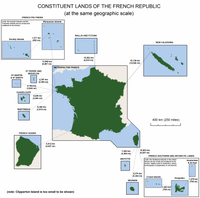
Photo from wikipedia
OBJECTIVES We aimed to describe factors associated with the choice of first ART in PLHIV in France, included the country of birth, as well as the time to undetectable viral… Click to show full abstract
OBJECTIVES We aimed to describe factors associated with the choice of first ART in PLHIV in France, included the country of birth, as well as the time to undetectable viral load and treatment discontinuation. DESIGN Observational study conducted from the national Dat'AIDS prospectively collected database. METHODS We included all adults who started their first ART between 01/01/2014 and 12/31/2020, with a pretherapeutic plasma viral load (pVL)≥400 copies/mL. Uni- and multivariable logistic regressions were used to analyze PLHIV characteristics driving to an INSTI-based first prescribed regimen. We also analyzed time to first line discontinuation, and to a first undetectable pVL, using Kaplan-Meier and Cox models. RESULTS We analyzed data from 9094 PLHIV: 45% men who have sex with men, 27% women and 27% heterosexual men; 48% born abroad; 4.7% and 2.8% with concomitant hepatitis B and tuberculosis, respectively. INSTIs were prescribed as first line therapy in 50% of PLHIV, which increased over time. Native French PLHIV were more likely to receive an INSTI-based regimen than PLHIV born abroad PLHIV (adjusted prevalence ratio 1.47, 95%CI 1.33-1.60), as were high pVL at diagnosis, hepatitis B or concomitant tuberculosis. Time before discontinuation the first ART and reaching a first undetectable pVL was not different according to the place of birth. CONCLUSION Despite unrestricted access to INSTIs in France, independently from HIV disease parameters, PLHIV born abroad received INSTIs less frequently as a first regimen than those born in France. Qualitative data are needed to better understand physicians' prescribing practices.
Journal Title: AIDS
Year Published: 2023
Link to full text (if available)
Share on Social Media: Sign Up to like & get
recommendations!